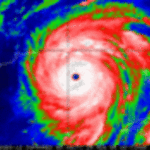During heavy rains or in spring when the snow melts, flash floods can often develop suddenly and unexpectedly. Flash floods alone kill an average of 200 Americans per year. More than half of these deaths are caused by people driving their cars during the flood. While property damage cannot be avoided, knowing some basic facts about floods and moving water can drastically increase your chances of survival.
Terms to know:
Flood Watch: Flooding is possible
Flash Flood Watch: Flash flooding is possible
Flood Warning: A flood is occurring or will occure soon
Flash Flood Warning A flash flood is occurring. Move to higher ground immediately on foot.
Preparation
Know how likely you are to have your home affected by a flood in advance. If you are at risk, it would be a good idea to get flood insurance. Also, have an evacuation route planned before a flood arrives.
Listen to the radio for weather information. Take routes that avoid flooded areas Information is readily available for. You can get this information from the NOAA Weather Radio All Hazards. In order to receive this information you should have a receiver with the Specific Area Message Encoder (SAME) that can warn you of flash flood alerts. NOAA Weather Radio uses seven channels: 162.400, 162.425, 162.450, 162.475, 162.500, 162.525, 162.550.
Even if there is a flood watch, it is a good idea to temporarily evacuate your house if you live in a low area and move to higher ground. You should be particularly on your guard if you live near a river or creek, as these are often the first places that flood during a heavy rain.
If you are staying in your home, unplug all electrical equipment. Plugged in equipment could electrocute you during a flood if the wires are cut open by the rushing water. If you don’t have time for this, be wary of electrical equipment that is wet and DO NOT TOUCH it.
Get clean water from the faucet immediately, about one gallon per person minimum is recommended and store for future use. This is to avoid you having to drink contaminated water during the flood.
· Also, be alert for gas leaks.
During the Flood
Try to avoid any contact with flood water if possible. Flood water is often contaminated with gasoline or sewage. Also, if power lines in the area are fallen, it may also be charged with electricity.
Driving through a flood is extremely dangerous. If a flood is coming your way, do not drive. Six inches of water is enough to reach the passenger seat and is enough to make you lose control of the car, a foot of water will float your car, and two feet is enough to sweep your vehicle in the direction of the flood.
If your car is flooded, immediately abandon it. Once the water reaches the level of the doors of the car, it will exert pressure making it almost impossible to open the doors and escape. You do not want to be trapped in your car during a flood.
If your vehicle is submerged in water because you did not follow the above directions for whatever reason. You’ll have to wait for the doors to be fully submerged in water. Then you can open the windows to let water in and then the doors will open. Swim to the surface of the water and try to remain somewhat calm. People have survived this before.
If you are forced to walk through water, walk only through standing water. Even six inches of running water is enough to make you fall.
If you’re swept into quickly moving water, point your feet downstream so that your head doesn’t hit any objects. Try to go over obstacles in your path, not under, to prevent being trapped under the surface of the water.
If you’re stuck on an object above the water level like an abandoned building or tree, stay there until you are rescued. Do not climb down and enter the water because this will reduce your chances of survival drastically.
Don’t return to flooded areas until you’ve been publicly authorized to. Just because water is receding does not mean that flood dangers are over.


